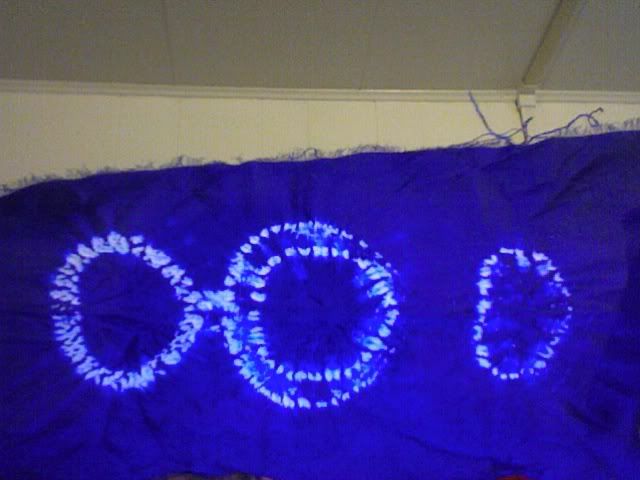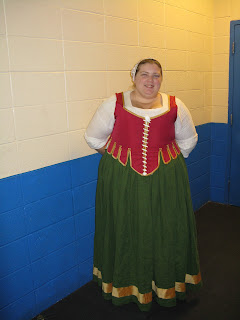June 22: ACC: Fabrics
My stash is pretty close to depleted, but I was able to pull all my fashion yardage from what I already have:

While this qualifies as stash, it's my newest purchase. I got it at a Hancock sale on Saturday ($5/yard!). It's a linen herringbone twill. It's wonderfully soft and floaty and will go toward a smock and probably also a partlet. There is also a japanese kosode in the works which will probably take the remainder of the bolt.

My corset is wearable so I can start fitting the dress but still needs several hours worth of work binding the bottom edges. There is enough gold silk to make bias tape for those edges, and I'm hopeful that there will also be enough to put some guards on a petticoat. The linen fabric on the right was originally yellow until I threw it into a blue dyebath, and now it's a great shade of foresty green, which will be really fun with the magenta corset fabric.

I had a picture of the blue on an earlier post, but here's a flash shot to give a little better idea of the color. The original fabric is a sort of creamy white in a kind of funny mystery weave (not quite taffeta, but not really anything else), but it's 100% silk, takes dye like a champ, and has a really nice crisp finish with a decent lining. There's enough to have some white silk to make the shoulder puffs, and maybe even to line a few things. My white kirtle is the undyed version of this fabric, and it was actually quite easy to work with.

For the ropa/overgown I decided to finally use this rayon velvet that was probably my first big fabric splurge (I bought 10 yards right after I graduated college; it was only $4/yard). It's a beautiful deep mulberry color that shines when it catches the light. I also have 20 yards of gold metallic bobbin lace (half bright gold, half antique gold) to trim it. While it might not coordinate perfectly with the dark blue gown, it'll look smashing with some other stuff I have (like my white kirtle). I foresee this fabric being a nightmare to work with, and much hand-basting in my future.
There are still little bits that I might not be able to pull from stash (canvas, linings, etc) but I'm pretty hopeful that the cost will be minimal.
June 21: Artemisian Costuming Challenge
So the call has been put out in our area for a challenge similar to the one started by
Realm of Venus recently, except it's open to any time period or locale used in the SCA. Since I had a brilliant idea for a gown anyway, I decided to join in. The challenge includes making the following between now and the end of the year:
1. A skin layer: for this I'll make a square-necked linen smock/chemise, possibly with some embroidery around the neckline, and a green linen petticoat made to coordinate with my corset (hopefully). I'll also finish my corset to wear along with it, though it might not count for the purposes of the competition.
2. The main garment: This will be a blue silk gown based on the portrait of
Margot de Valois with silver (yeah, I decided on the silver) couching.
3. An outer layer. I'm much more iffy on this (my whole point with the original gown was that I wouldn't need the extra layer) but if it's doable after everything else is done, I'm thinking of a loose gown with a high neck, similar to this one worn by Margot's sister Claude:

It's very similar to portrayals of Italian zimarra, so I might take some cues from that angle. I have no idea what it will be yet, because there's nothing in my stash that would work for it. Hastings recommended a dark purple fabric lined in pink, which sounds fantastic with a heavy satin and linen, but we'll have to see.
4. An accessory. Any number of things can apply to this, but I'm thinking anything from the following: a zibellino (probably with a lot of help from Holly), a partlet, stockings, tablet woven garters, a feather fan, etc.
There is also a price limit of $100, but stash materials can be used. I can actually cover quite a bit from my stash, but I'll still need a lot of notions and shiny bits.
June 15th: New Project
I'd gotten some sapphire blue dye from Dharma in a futile attempt to get some silk embroidery thread that matched my blue 15th century kirtle (It tangled homelessly in the dyebath and I gave up on it when I found a thread that worked). Drew pulled it out last week to do some shibori experiments, and it is the most brilliant color of blue imaginable.

The photo barely does it justice. I just stared at the sample scraps longingly before I turned my sights to the entire bolt still left over from both of our projects. It turns out we still have over 8 yards, which demanded to be turned into a blue gown, so I called dibs.
I thought about doing a new Tudor, but the silk itself has a pretty soft drape, and even with the dye job giving it a crisper, more taffeta-like finish, I wasn't sure it would play well with the big sleeves of a typical tudor gown. Besides, I already have one of those in the works.
So I went a little later, to the work of Francois Clouet in the 1560s, and I found this portrait of Margot de Valois as a small girl:

And there it was. The dress that I must now have. The work involved tailoring-wise is pretty simple compared to my other projects -- there's really only one visible outer layer, and I don't even need a petticoat if I don't feel like having a split skirt in the front (and I'm thinking I don't). The sleeves are simple other than some classy embellishment and unique shoulder treatments, which are not huge and bulbous like what you see in England, nor are quite as crazy poufy and/or complicated like what you'd find in Italy.
Adult women wore this stuff too:

Claude de Châteaubrun de Beaune dame de Gouffier, by Francois Clouet, c. 1560s (and yes, there are plans for a zibillino too, now that I can finally succumb to that particular fad)
My big internal conflict now is trying to decide if I want to do the embellishment in gold or silver. Gold seems to be standard for just about everything in the period, and jewelry-wise it would look really great with the pearls. Silver is used occasionally (it's certainly on Margot's gown), would be better suited toward my heraldic colors, and would be really eye catching couched on the blue. Using both at the same time seems cheesy. Decisions, decisions.
June 8th: I did a Thing!
Noelle asked if I could make her some garters for when she becomes a Laurel at Baron's war (big prestigious award in the SCA for historical arts), and gave me free reign over the design, so I decided to do not one but two techniques that were completely new to me: brocading, and warp twine manipulation. I'm playing a little fast and loose with specific time periods and places (though all of them are within the medieval period), mostly because I'm using design elements that are especially significant for the recipient. It's woven with a Kanagawa 1000 denier silk that Noelle purchased and sent my way.
Here are my patterns:


The fleur-de-lis and leaf vine (reminiscent of laurel leaves, yes?) are from Ecclesiastical Pomp and Aristocratic Circumstance, about the 13th and 14th centuries maybe (I don't feel like checking right now). The vine was originally for 13 cards and was sized up to work with a 25 card band, but the fleur (which is 17 cards wide) was alternated between sides to fill up the space.

The brocading worked fabulously, even with my wonky tension at the beginning. This portion is for the tails of the garters, which are 5 fleurs long, or maybe 3-4 inches. It's done with a Kreinik gold braid.
I was so tempted just to do the whole thing in this brocade pattern but it's really slow and the gold braid makes it a little stiff and potentially pokey.

The main body of the garters are the warp-twined laurel leaves. I can't capture it very well because the effect is very subtle, but the design comes about by turning the relief backwards and the rest forwards. This technique was in Peter Collingwood's Techniques of Tablet Weaving and is document-able to the 10th century. It's also pretty slow, but I get a lot of satisfaction of splitting up the pack and turning them in different directions.
I'm maybe six inches in, and have 36 or so more to go.
















































